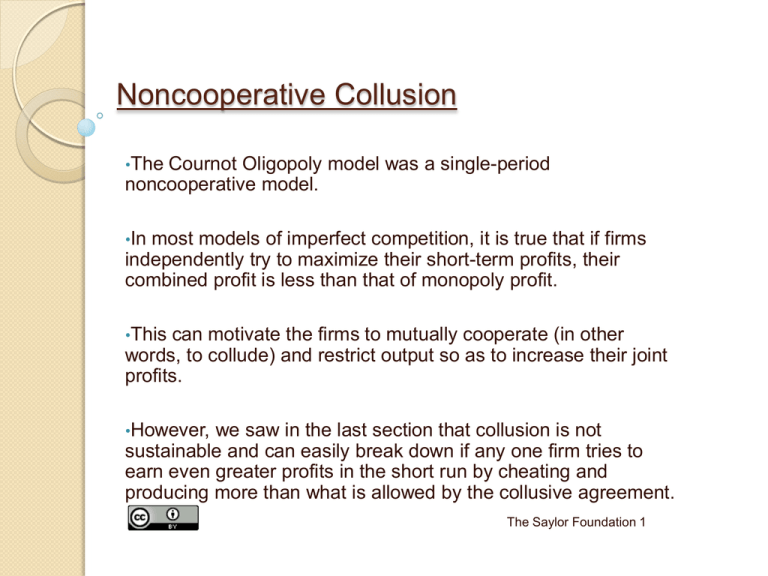Noncooperative Collusion
advertisement

Noncooperative Collusion •The Cournot Oligopoly model was a single-period noncooperative model. •In most models of imperfect competition, it is true that if firms independently try to maximize their short-term profits, their combined profit is less than that of monopoly profit. •This can motivate the firms to mutually cooperate (in other words, to collude) and restrict output so as to increase their joint profits. •However, we saw in the last section that collusion is not sustainable and can easily break down if any one firm tries to earn even greater profits in the short run by cheating and producing more than what is allowed by the collusive agreement. The Saylor Foundation 1 Noncooperative Collusion continued… Look a the game below (the Prisoner’s Dilemma), where “high” and “low” imply the levels of output produced by each firm: Firm 1 high Firm 2 hig h low low 50,50 70,40 40,70 60,60 We assume that this game is repeatedly played by the two firms. ◦ If both firms cooperate and produce low output, both get 60 in every period. ◦ If one firm cheats and produces “high” while the other firm produces “low,” its payoff is 70 in the first period, and 50 in every period thereafter. The Saylor Foundation 2 Noncooperative Collusion continued…. If a firm cheats and does not restrict output as planned, the cheating is detected after the first period with the result that the other firms retaliate. So why would a firm cooperate and what would deter the firm from cheating? Answer: Firms engage in noncooperative collusion if the present discounted value of income earned in the long run by cooperating is greater than the present discounted value of income earned in the short run by cheating and accepting retaliation. Assume µ is the discount factor (see notes below) The Saylor Foundation 3 Noncooperative Collusion continued…. In terms of the prisoner’s dilemma game, if µ is the discount factor, then the firm that cooperates forever, has the pay-off : 60+60µ+60µ2+60µ3+….. and the firm that cheats has the following pay-off: 70+50+50µ+50µ2+50µ3+…. The collusive outcome may be enforced in all periods only if 60+60µ+60µ2+60µ3+…..>70+50+50µ+50µ2+50µ3+…. or, 60/(1-µ) >70+50* µ/(1- µ) or, µ>1/2 Intuition: If the discount factor is large enough (i.e., if the firm cares enough about future payoffs), it will not cheat to increase profits in the short run. The Saylor Foundation 4 Noncooperative Collusion continued… In a market where firms repeatedly play the Prisoner’s Dilemma game, firms can learn from their rivals’ actions and punish each other for deviating or cheating. Such games are called “trigger strategies” (i.e. deviation “triggers” punishment). Thus, every firm cooperates in the first period and in each subsequent period they review their rivals’ actions before making their decision as to whether to cooperate or not . Trigger strategies work in the following way: ◦ Begin by cooperating ◦ Cooperate as long as the opponents do ◦ Upon observing a deviation, immediately revert to a period of punishment of specified length in which everyone plays noncooperatively Two extreme forms of trigger strategies are: ◦ The Grim Trigger Strategy ◦ Tit-For-Tat The Saylor Foundation 5 Noncooperative Collusion continued… In the Grim Trigger Strategy, punishment continues indefinitely if an opponent deviates. The following rules define a Grim Strategy: ◦ Cooperate every period until an opponent deviates ◦ If deviation occurs in any given period, play non-cooperatively for the rest of the game For Grim Strategy, the Present Discounted Value implies: ◦ Cooperate if PV(Cooperation) >PV(Defection) The Saylor Foundation 6 Noncooperative Collusion continued… In Tit-For-Tat, you copy what your rivals have done in the previous period. The following rules define a Tit-For-Tat game: ◦ Cooperate if your opponent cooperated in the most recent period and ◦ Deviate if your opponent cheated in the most recent period For Tit-for-Tat, the Present Discounted Value implies: ◦ Cooperate if PV(Cooperation) >PV(Defection) AND ◦ PV(Cooperation) >PV(Defect once) The Saylor Foundation 7 Tacit Collusion: Tacit Collusion occurs when firms engage in limiting output and raising prices in such a way that they raise each other’s profits without making any explicit agreements with each other. Tit-for-Tat is often a good strategy in repeated Prisoner’s Dilemma games and may lead to successful tacit collusion. Price leadership is another form of tacit collusion in which a firm (usually the largest in the industry) sets the price first. The other firms then follow suit. Although there is no formal agreement, the other firms have a tacit understanding not to compete against price. Rather, they indulge in non-price competition (for example, advertising) to increase their sales. Since antitrust policies prevent industries from legally colluding, most industries engage in tacit collusions and succeed in keeping their prices above their noncooperative levels. However, there are limitations to tacit collusions. The major factors that can inhibit an industry from coordinating high prices include differences in interests amongst firms. If the firms have different perceptions of what is fair and what is beneficial to each, it may become difficult for firms to cooperate with each other. Also, if the number of firms is large, there is less incentive to cooperate and it becomes more difficult to do so. Another limiting factor is when oligopolists sell to large buyers who may bargain for lower prices. The Saylor Foundation 8







